#crawford topaz
Text
Maj was walking along the shore when she saw him. She couldn't believe after all this time they'd finally run into each other. It wasn't like she was actively avoiding him. She was in the beginning but their paths just didn't cross after that. Seeing him now, Maj wanted to turn and walk the other way but he had already saw her. She tried her hardest to look confident and not like a nervous wreck. When they got closer to each other, Maj stopped and waved, "Hey, Ford." @mcnstercus

3 notes
·
View notes
Text
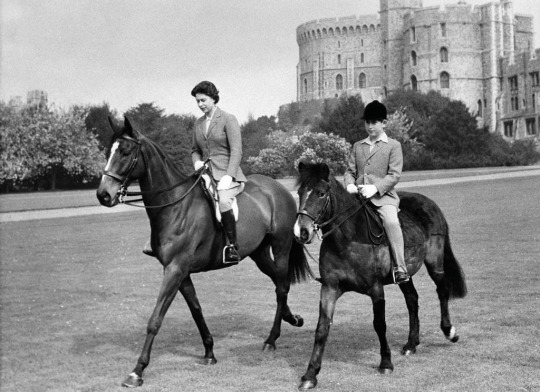
A royally good start
Horse & Hound | Published 20 June 2021
WHEN The Queen’s childhood governess Marion Crawford first met a young Princess Elizabeth, she found “a small figure with a mop of curls sat up in bed”, who had tied the cords of her dressing gown to the knobs of the bed and was busy driving her team.
‘‘Do you usually drive in bed?” Marion remembered asking, in her 1950 book The Little Princesses, to which the princess replied: “I mostly go once or twice round the park before I go to sleep. It exercises my horses.”
The 30-odd toy horses that she had, each standing a foot high on wheels, had a strict stable routine; their grooming basket stood at the end of a long line of them, first at No. 145 Piccadilly, and later in the corridors of Buckingham Palace. Each night they had their saddles removed, and were attentively fed and watered. And after her and Princess Margaret’s annual trip to Olympia Horse Show with their parents, the toy horses would be put through several weeks of intensive training. On other occasions Princess Elizabeth would harness her nanny with a pair of red reins to set off on a fictional delivery round.
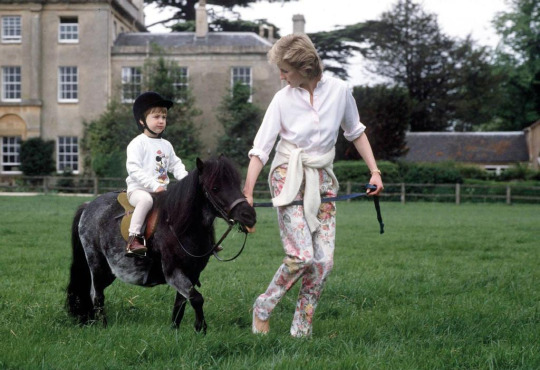

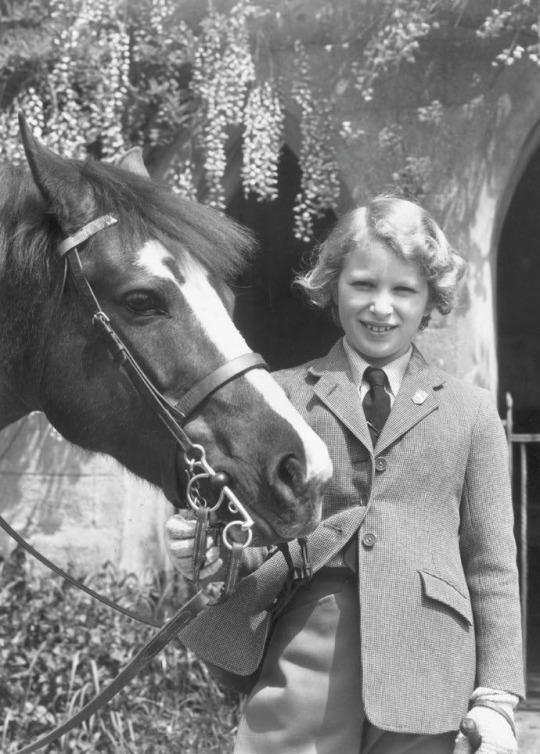
“I would be patted, given my nosebag, and jerked to a standstill, while Lilibet delivered imaginary groceries, and held long and intimate conversations with her make-believe customers,” wrote Marion. “Sometimes she would whisper to me, ‘Crawfie, you must pretend to be impatient. Paw the ground a bit.’ So, I would paw.”
And at Royal Lodge, in Windsor Great Park, where weekends were spent, two lifesized rocking horses were put outside the then Duke of York’s study, so he could hear his daughters riding while he worked.
WHEN Princess Elizabeth’s grandfather King George V gave her the diminutive Shetland Peggy when she was four years old, it was her first real taste of life in the saddle - and a place for her to channel the attentiveness she’d shown her toys. A photo from the 2014 exhibition Royal Childhood at the Summer Opening of Buckingham Palace shows her proudly leading her younger sister aboard Peggy, with the bowler-hat clad groom Mr Henry Owen, who taught her to ride, in attendance.
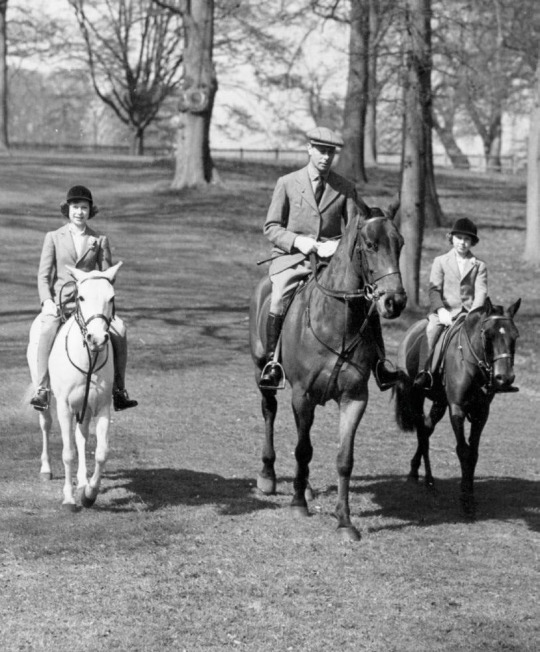
“[Princess Elizabeth] liked me to come and watch her [riding lessons with Mr Owen],” wrote Marion. “Her first canter was a great day. I used to walk with the dogs, and it was pretty to hear her bell-like voice through the trees talking to Owen about burs, galls and girths.”
For all the stereotyping of Shetlands being comically naughty, they have continued to be the royal family’s choice of breed for a child’s debut in the saddle. It was Queen Victoria’s fondness for the breed that helped raise their profile in the 19th century, according to Anne, Countess De La Warr, president of the Shetland Pony Stud Book Society.
“It made them popular with other Victorian mothers,” she says. “They’re particularly good as a first pony, but also as what I call a family pony; if you have a trap or a cart, you can all go on family picnics with them. I have one friend whose pony is said to know his way to the pub.”
Flora and Alma, two Shetlands who were presented to Queen Victoria by King Victor Emmanuel of Italy, proved particularly popular with her grandchildren, and it’s a trend that Anne continues to see today.
“Grandmothers can have them in the field and when a child comes to visit, you can hoik them out and put a saddle on. They’re amazingly easy,” she says.
If it weren’t for the grand surroundings, BBC footage from 1992 of The Queen with Princesses Beatrice and Eugenie riding Smokey at Balmoral could be any idyllic scene of a grandmother with her grandchildren.
As Anne explains, the best Shetlands tend to come via word of mouth and the royal family is no exception in following that ethos on the hunt for the perfect pony. Prince William learnt to ride on the pint-sized Smokey aged four; Llanerch Topaz, another that the future king was pictured on as a child taught the Princess Royal’s children to ride and it was reported that Zara Tindall provided a Shetland for Prince George to kick-start his riding.
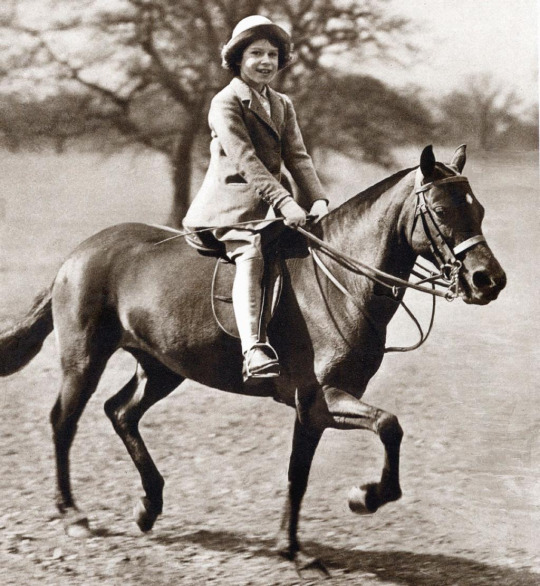
WHILE these early rides are the grand sum of some royal family members’ foray into equestrianism, for others it is just the start. Aged two, Princess Anne was bundled aboard Fum, and although her memories of the Shetland are vague, the experience paved the way for a series of more memorable ponies that would lay the foundations for her Olympic eventing career.
Holidays as a child were spent at Sandringham, Windsor and Balmoral. Each offered a different terrain for Princess Anne to tackle on horseback, usually accompanied by her mother and older brother, and assisted by the groom, Frank Hatcher, who helped the children catch the ponies and brush them, and reminded them to pick out their feet.
“The miles of stubble fields around Sandringham were pure luxury by today’s standards of relatively restricted hacking,” she remembered in her 1991 equestrian autobiography Riding Through My Life, reminiscing about the “rides” which had been cleared for Queen Alexandra to be able to ride through the woods and all over the estate without getting her hat knocked off.
“The best ‘fun’ riding was at Balmoral: riverside paths, woodland paths, hill paths and the golf course. It was all right if you rode on the rough, but you were definitely not popular if you got ‘carted’ away with across the fairways.” As for a young Princess Elizabeth, who won a driving class at the 1944 Royal Windsor Horse Show with her Norwegian pony Hans, Princess Anne’s initially modest competitive career started from Windsor, where most of her riding happened at weekends (although not on Sundays, which was the grooms’ day off).
She was a member of the Garth Hunt branch of the Pony Club - although she can count the number of rallies she went to on one hand.
“They were memorable for persuading me that gymkhana games were not my forte. The pony I had at the time was a 13.2hh called Bandit, who was charming and reliable in every way except that he refused to repeat himself. By that I mean that he would take part in one bending race, but tried very hard not to take part in the next,” Princess Anne wrote in her autobiography.
It was this same pony that knocked a young Prince Charles’s confidence when it came to jumping. On clearing one round the grey was known to “indulge in his well-known imitation of a horse rampant if asked to face up to round two,” remembered Princess Anne. Discovering hunting helped renew the Prince’s interest in jumping, and being introduced to polo by his father at the age of 13 was a world away from the tedious early lessons inflicted on him and his sister with Miss Sybil Smith at Holyport.
Princess Anne remembered: “Being put on a small, fat, white cob, on the end of a leading rein, one each side of a large, fat, white cob, ridden by Miss Smith, and being led, very sedately, around a cinder circle was not our idea of riding!”

Even with the abundant privilege, being royal couldn’t negate the calamities that accompany getting to grips with ponies. On holiday at Glamis Castle, the childhood home of the Queen Mother, a favourite expedition for Princesses Elizabeth and Margaret was to take the pony down to Glamis Station to watch the Aberdeen Fish Express go through.
“The pony was temperamental about trains, and the station master very kindly let us shut him up in the waiting room,” remembered governess Marion Crawford. “Unfortunately, one day when, as usual, we did this, the stationmaster had forgotten to warn us that he had put all his best chrysanthemums ready for the flower show in there. The pony ate the lot.”
A tumble came for Princess Anne when riding her bay 14.2hh Watersmeet High Jinks in from the field while leading another, and making an unplanned dismount on some hard cobbles. “Not for the first time he looked genuinely surprised at the antics of his erstwhile rider,” she wrote.
An earlier mount, Kirby Cane Greensleeves, left a lasting imprint on the Princess after the Welsh pony trod on her toe. “In that endearing way that ponies have, the more I shouted, the more I pushed and the more desperate I became, the harder she leaned,” she wrote.
And while the royal ponies might have nestled alongside horses reserved for pulling golden state carriages when they were stabled at Windsor Castle, it was often a refreshingly low-key existence. At Windsor, the ponies lived a distance from the Mews, so the children would take the tack down in the car, tack them up in the field and take them out from there.
“These were pretty rough, scruffy little objects,” remembered Princess Anne.
What was drummed into the children however by The Queen was that whatever went wrong, it was never the ponies’ fault. Along with Zara’s Pony Club grounding, this was a mantra that Princess Anne instilled in her own children, and one that seems likely to exist for the next generation.
“There is no doubt that the level of involvement required in equestrian sport teaches young people a great deal about life, especially that ‘life’ is not fair,” wrote Princess Anne. “Horses are no respecters of reputation or ego and certainly not of wealth, making them a challenge to everybody, whether looking after or riding them.”
Pictures by AFP via Getty Images, Tim Graham Photo Library via Getty Images
#queen elizabeth ii#princess anne#princess royal#zara tindall#prince william#prince george#king charles iii
51 notes
·
View notes
Text
crawford topaz's about information has been updated here.
0 notes
Photo
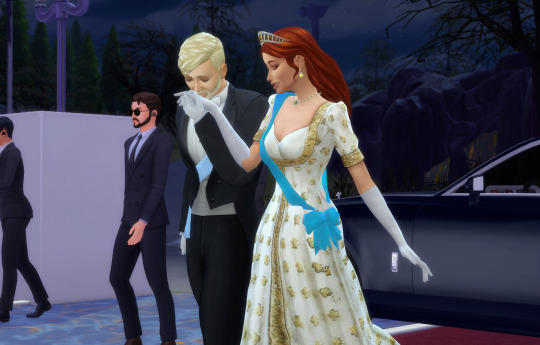
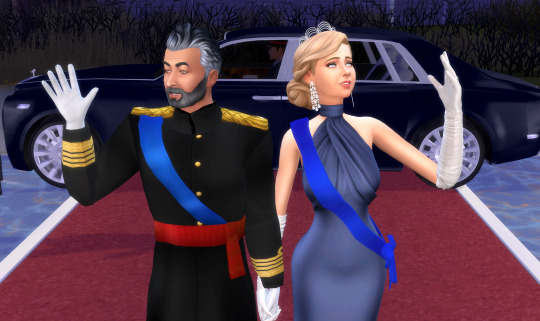

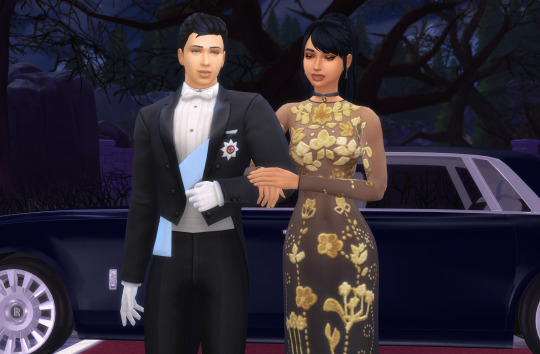


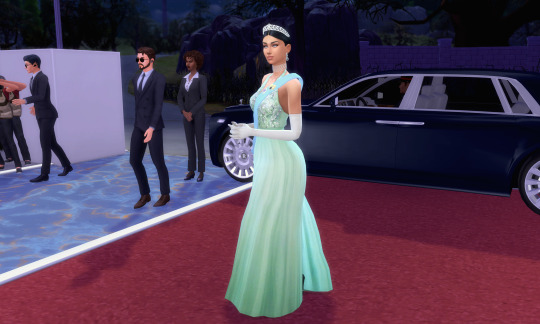
Harwood Winterfest Ball - Arrivals Part II
More esteemed guests are here at Harwood Manor for the annual Winterfest Ball; arriving now are TRH Prince Rhys, Duke of Andale and the Duchess Claire. The two share an adorable bit of PDA before stepping into the ballroom. The Duchess borrowed a lovely topaz tiara from the Royal Vault for the event, a piece made for the previous Queen Ana that remained unworn.
The next couple we see arriving are the Duke and Duchess of Ely waving happily to the press. The Duke, who is a good friend of the Crown Prince Arden of Lunaria, has apparently had a bit of a falling out with His Highness recently. Rumors have been going around about HM King Vincent’s imminent abdication which will lead to the Crown Prince’s coronation but according to Lunarian law, he will have to get himself a Queen Consort! The Duke of Ely has reportedly been trying to convince HRH to take a new wife which has driven a wedge between he and the Crown Prince.
After her parents we see the beautiful Lady Larissa Ely escorted by HRH Prince Matthew of Andale. The two are officially announcing their relationship at tonight’s event, though they have been seen out and about together for a few weeks now.
Next we see HRH Prince Charles with Miss Alivia Acharya. The two have been caught up in quite the scandal these past two weeks after paparazzi pictures surfaced of the two getting a little to close for Ambassador Acharya’s comfort. The Ambassador was furious with the young couple and rumor has it that he wasn’t able to be appeased until HM King Vincent proposed a marriage between the two! That’s right, looks like Charles is going to be tied down after graduating from his chosen university.
The next controversial couple we spot are HRH Prince Nicholas and Lady Anissa Crawford. The two are apparently “on” again after having reportedly broken up after a very public fight two weeks ago. Easy-A was all over HRH for the event tonight and Nicky definitely seemed to be enjoying it. Lunarians everywhere are disappointed to see the two back together again if we’re being honest.
After Nicky we see our favorite couple in the Lunarian Royal Family, River and Amina Quinn. The two left their little ones at home in Sulani with one of their maternal uncles and were heard to be excited to finally have a night out when asked by the press.
Finally, we see HRH Princess Annaliese once again wearing her mother’s famous Halo Scroll Tiara. Unfortunately the Princess arrives all alone unlike her two older brothers; Ana is reportedly uninterested in finding love at the moment according to close friends. Despite being pursued by many HRH seems to be more interested in her school work. Still, it’d be nice to see at least one normal, happy couple in the Lunarian Royal Family again and something tells us Annaliese might be our only hope!
#ts4 monarchy#ts4 royalty#ts4 royals#ts4 royal family#ts4 royal#ts4 royal legacy#ts4 legacy#sims 4 royals#sims 4 royal family#sims 4 royal legacy#sims 4 royalty#sims 4 royal#sims 4 monarchy#sims 4 legacy#sims4 royal family#sims4 royals#sims4 royalty#sims4 legacy#sims4 monarchy#sims4 royal legacy#sims4
13 notes
·
View notes
Photo

member groups.
in an attempt to merge the gap between real life and urban fantasy, we’re doing something a little different with the member groups than some fans of this muddled genre might be used to. each one will attempt to represent a good balance and mixture of different things that your character can relate to. we don't want anyone to feel too boxed in, so try not to overthink where your character belongs. whatever feels right for you and your character is the right answer!
honey.
gluttony, kindness.

fictional parallels: jughead jones, alana bloom, pacey witter, xander harris, charles boyle, alex manes, chloe decker, julie james, mouth mcfadden, waverly earp, dean winchester, luke crain, raven reyes, dewey riley.
traits might include: nurturing, warmth, self-deprecation, curiosity, indulgence, courage, self-sacrificing, glib, loyalty, resourceful, headstrong.
moss.
envy, humility.

fictional parallels: toni topaz, andie mcphee, will graham, buffy summers, nicole haught, terry jeffers, maria deluca, peyton sawyer, dan espinoza, sam winchester, shirley crain, clarke griffin, randy meeks, elsa shivers.
traits might include: woeful, selfish, excitement-seeking, artistic, nearsighted, honest, impulsive, stubborn, practical, inconsistent, moody.
saltwater.
pride, temperance.

fictional parallels: veronica lodge, audrey liddell, xavier dolls, kyle valenti, brooke davis, amenadiel, raymond holt, rupert giles, jack crawford, castiel, olivia crain, bellamy blake, sidney prescott, helen shivers.
might include: self-aware, brazen, extroverted, inspirational, arrogant, determined, charismatic, secretive, independent, ostentatious, self-righteous.
satin.
greed, patience.
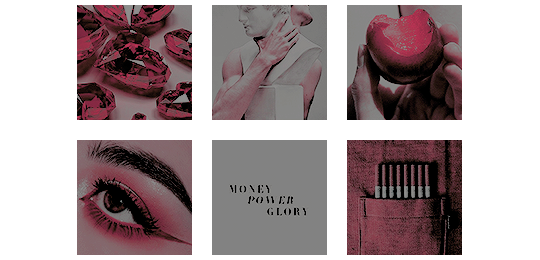
fictional parallels: cheryl blossom, dawson leary, doc holliday, max evans, chris keller, mazikeen, gina linetti, spike, steven crain, freddie lounds, bela talbot, john murphy, billy loomis, barry cox.
traits might include: materialistic, clever, intense, opinionated, collected, unpredictable, manipulative, dominant, addictive, magnetic, efficient.
thunderstorms.
wrath, diligence.

fictional parallels: betty cooper, joey potter, bobo del rey, michael guerin, nathan scott, linda martin, amy santiago, faith lehane, hannibal lecter, john winchester, theodora crain, octavia blake, stu macher, bill willis.
traits might include: choleric, focused, vengeful, challenging, pensive, rebellious, active, steadfast, ingenious, aloof, combative.
wisteria.
lust, charity.

fictional parallels: kevin keller jen lindley wynonna earp isobel evans lucas scott lucifer morningstar roza diaz cordelia chase gabriel hugh crain jasper jordan ghostface ray bronson.
traits might include: charming, generous, passionate, naive, imaginative, physical, humanitarian, philosophical, indecisive, playful, trusting.
woodsmoke.
sloth, chastity.
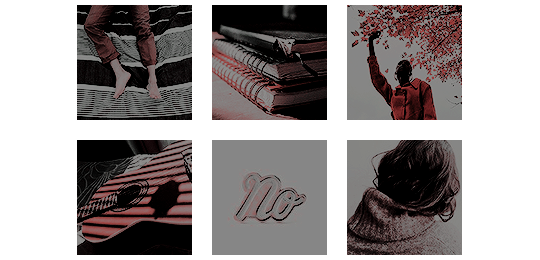
fictional parallels: archie andrews jack mcphee jeremy chetri liz ortecho haley james scott ella lopez jake perolta andrew wells abigail hobbs jack kline nell crain monty green gale weathers max neurick.
traits might include: intelligent, aimless, grounded, sensual, detached, ethical, indolent, witty, observant, melancholic, theoretical.
4 notes
·
View notes
Text
Chicago Blackhawks birthstones
David Kampf: January 12th (Garnet)
Ryan Carpenter: January 18th (Garnet)
Kirby Dach: January 21st (Garnet)
Slater Koekkoek: February 18th (Amethyst)
Matthew Highmore: February 27th (Amethyst)
Alex Nylander: March 2nd (Aquamarine)
Dylan Strome: March 7th (Aquamarine)
Connor Murphy: March 26th (Aquamarine)
Zack Smith: April 5th (Diamond)
John Quenneville: April 16th (Diamond)
Brent Seabrook: April 20th (Diamond)
Jonathan Toews: April 29th (Diamond)
Calvin de Haan: May 9th (Emerald)
Dylan Sikura: June 1st (Pearl)
Nick Seeler: June 3rd (Pearl)
Drake Caggiula: June 20th (Pearl)
Lucas Carlsson: July 5th (Ruby)
Duncan Keith: July 16th (Ruby)
Andrew Shaw: July 20th (Ruby)
Adam Boqvist: August 15th (Peridot)
Dominik Kubalik: August 21st (Peridot)
Olli Maatta: August 22nd (Peridot)
Brandon Hagel: August 27th (Peridot)
Nicolas Beaudin: October 7th (Opal)
Brandon Saad: October 27th (Opal)
Dennis Gilbert: October 30th (Opal)
Patrick Kane: November 19th (Topaz)
Alex DeBrincat: December 18th (Turquoise)
Malcolm Subban: December 21st (Turquoise)
Corey Crawford: December 31st (Turquoise)
4 notes
·
View notes
Photo

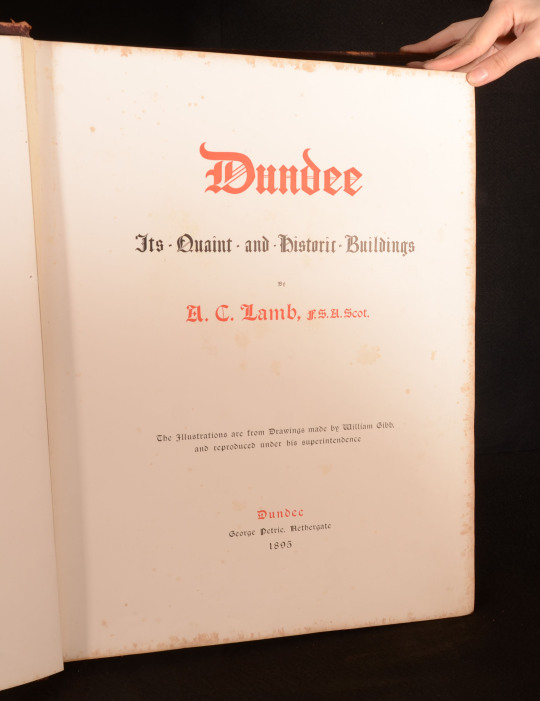
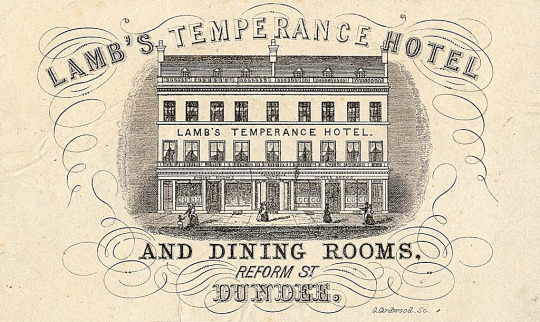
On January 21st 1843 the hotelier, art collector, antiquarian and writer Alexander Crawford Lamb was born in Dundee.
A. C. Lamb became aware that in 1871 old buildings were disappearing due to the implementation of the Improvement Act. He therefore sought to record their existence by collecting views of anything which illustrated Dundee's trade, commerce and the activities of its citizens. Apart from being a collector of artefacts, A. C. Lamb also spent many years producing a piece of work illustrating the history of Dundee, called “Dundee: Its Quaint and Historic Buildings'”.
Lamb's hotel business was very successful and presumably provided the financial means whereby he amassed the immense Lamb Collection which "now forms one of the largest and most varied collections of local history material in Scotland".
On his death the collection was acquired by Edward Cox and donated to the City of Dundee. The artefacts "The Lamb Collection" are now in the City Museum.
The legacy of A,C Lamb also includes 450 boxes of ephemera, including maps, photographs, books and prints would have been lost to future generations. He was also a friend of the world famous tragedian poet William Topaz McGonagall, in his memoirs the great poet wrote about meeting Lamb before he left to spread his genius in the U.S......
".....when I called to bid him good-bye, and after we had shaken hands warmly, he asked me if any of my pretended friends had promised to take me home again from America if I failed in my enterprise. So I told him not one amongst them had promised. “Well,” says he, “write to me and I will fetch you home.”
More on Lamb and his collection here https://sites.scran.ac.uk/lamb/main.htm
9 notes
·
View notes
Text
Myrna Loy: Keeping Cool
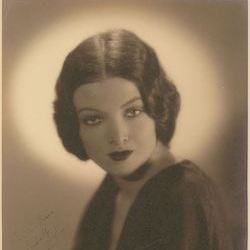
If an actor is said to be “underplaying,” what does that mean exactly? It might mean not doing the obvious thing and not displaying the obvious emotion. Or it might mean feeling various emotions but holding them back and only sharing a tiny portion of them. This is a risky strategy, because most audiences might just think you can’t “act,” at least not in the expected way. When Myrna Loy made The Rains Came (1939), she was thirty-four years old and an established star. The film is what used to be called a “well-mounted” production, filled with dramatic incident and exotic settings and lots of extras and love crises and natural disasters. The role of Lady Edwina Esketh, a dissolute, promiscuous noblewoman who redeems herself through sacrifice and love, would seem to provide a juicy opportunity for showboating. It’s easy to imagine Bette Davis in the role, her eyes popping with restless desire. Whereas Loy had the kind of eyes that always seemed half-closed even when they weren’t.
Loy’s playing of Lady Esketh is cool, modest, almost non-committal, and this approach can seem alienating at first, but if you focus closely on what she’s doing, her under-the-radar work starts to pay dividends. The film’s producer Darryl Zanuck called her into his office midway through the shooting and complained about her performance, but Loy stuck to her own interpretation. She was known for her dry handling of light comedy, high comedy, even farce, and she refuses to play Lady Esketh full out as temperamental or mercurial, as practically any other actress of her time would have done. Instead, Loy keeps her cards close to her vest and lets her knowing attitude do the rest. Her expressive voice is light and almost fey, but very grounded, with ringing intonations, and this makes it different from a huskier yet more vacillating voice like Jean Arthur’s.
Even when Lady Esketh changes her tune, Loy doesn’t go all Noble. In fact, underneath the self-sacrifice her Lady Esketh seems to be as flip and above-it-all as ever, somehow, and this works well for the film. “I hate scenes,” she tells her lover George Brent, and this would be a laugh line for a Davis or a Joan Crawford, but Loy is an actress who actually does hate “scenes” or drama. She’s basically detached, but that doesn’t mean she doesn’t have feelings. It’s just that she doesn’t parade them around as other performers do.
This instinct Loy had for underplaying didn’t always work out so well. In Parnell (1937), Loy and Clark Gable do a lot of walking around and talking quietly to each other, and they come off like zombies in period dress. But her moderation in many other films was so unusual and original that Loy fashioned her very own type of screen character. She was almost never a working girl, but more usually a wife, a mistress, a lady with money and time for play, so fetching that she got away with lots of nose wrinkling and eyelash fluttering without ever seeming coy.
As a young girl, Loy had seen Eleonora Duse on the stage, and she had admired the restraint of that fabled actress. “Oh, I could have cried all over the place in many of my films, but it just didn’t feel right,” she said in her charming 1987 memoir, Being and Becoming. “The audience loses respect for the character. It seems that instinctively I’ve done this kind of underplaying a good deal in my work. That brand of acting had impressed me since first seeing Duse. She had an inner light, you see; you’ve got to have it…You can’t be thinking about how many people you’re having for dinner.” According to Loy in her book, nearly all of her leading men and many of the other men she met developed crushes on her, and that’s understandable. She had the damndest nose, turned up at the end and elaborately structured, and that reserved, hard-to-get manner that promised the deepest bliss if you could melt some of her reserve.
Loy was born in Montana, and she began her career early as a dancer in live prologues for silent films. She was an extra in the original Ben-Hur (1925), and for the next nine years she made eighty-odd movies, mostly in bits. As a maid in Ernst Lubitsch’s So This Is Paris (1926), Loy just walks across a room. She’s a lady in waiting to Lucrezia Borgia in Don Juan (1926) and a chorus girl in the first talking movie, The Jazz Singer (1927), and she was continually cast as vamps and tramps, often of Chinese, Latin or all-purpose “foreign” extraction.
In her first full talkie, The Desert Song (1929), Loy plays Azuri: “That name means tiger claws!” she informs us, in a hilariously BEEG! accent that she came up with herself. She’s very sexy in that movie, but she’s also making a kind of joke of sex, and this campy attitude also informs her Yasmini in John Ford’s The Black Watch (1929) and her gypsy temptress Nubi in The Squall (1929). Loy is enjoyably over the top in these roles and in some of her other vamp parts of this time, and she worked so often in this exaggerated fashion that maybe she was just all tired-out by the time she became a star in 1934 with The Thin Man, and so she made a low-key style out of this tiredness.
Loy is a hoot in The Truth About Youth (1930) as a gold-digging singer with a temper, and she was time-stoppingly lovely in her brief role in Ford’s Arrowsmith (1931). She had one promising scene with Robert Young in New Morals for Old (1932), but then the film drops her entirely. Loy steals Rouben Mamoulian’s Love Me Tonight (1932) with just a couple of naughty lines, socking them home in an attention-getting way that’s rather far removed from her later laidback delivery, but she was still being cast as vixens in racist concoctions like The Mask of Fu Manchu (1932), where her Fah Lo See delights in having men whipped, and Thirteen Women (1932), where her hypnotic half-caste takes methodical revenge on a bunch of sorority girls who spurned her. It must have taken much stamina and patience to wait out all these years and all these small and unworthy parts. She had a lead in a modern dress version of Vanity Fair (1932), which was shot in ten days at a poverty row studio, sometimes from 4AM to 4AM. Loy does an intriguingly subdued Becky Sharp, but maybe she was too exhausted to play it any other way.
The speedy director W.S. Van Dyke took her in hand in 1933 at MGM, and her parts began to improve. She thrived with John Barrymore in the sophisticated comedy Topaze (1933), and she fell in with her best partner, William Powell, in Manhattan Melodrama (1934), where she also tussled with Clark Gable. The Thin Man was made by Van Dyke in sixteen days, and it set up a long-running formula for Powell and Loy that proved irresistible. As Nick and Nora Charles, a private detective and his heiress wife, Powell and Loy struck up a bantering attitude with each other that still feels like a fresh and attainable ideal of marriage.
The mystery plots of their six Thin Man films were usually perfunctory, but that didn’t matter because audiences really came to see Nick and Nora verbally jousting and keeping each other entertained. Just listening to them is a pleasure: Powell with his deep, plummy voice and Loy with her bright, high, tinkling one. “They hit that wonderful note because he always did a wee bit too much and she underdid it, creating a grace, a charm, a chemistry,” observed George Cukor.
Nick and Nora are party people, and the running gag in their films is that they always want to get a rest or take a break but they never seem to, and that suits Loy’s Nora just fine. She married Nick for excitement and great sex and teasing that always goes right up to the edge of being dangerous but never topples over into hurt feelings (it did just one time, in After the Thin Man (1936), when Nick drunkenly mentions making a mistake and Nora for a brief moment thinks he means he was mistaken in marrying her because her family is so stuffy). Nora can be slightly dizzy, but she is also flexible and tough. “There’s a girl with hair on her chest!” says a cop in The Thin Man, after Nick and Nora have just gotten out of a scary scrape with a gunman and she comes out blithely crying for more action.
As she watches Nick shooting the ornaments off their Christmas tree in The Thin Man, Loy shoots Powell an only semi-loving “You are beyond belief” look, a very modern kind of juicily sarcastic look that is also in some sense unreadable. Nora’s love for Nick is a private and multi-leveled thing, and Loy will only reveal a small bit of it. They both see the fun or absurdity in practically any situation, even things that would irritate most of us. “We were married three years before he told me he loved me,” Nora says in The Thin Man Goes Home (1944), and she relates this in an admiring way, because they both like to avoid the obvious, or look askance at it.
The seven or so other films Loy made with Powell were often ordinary, but they were always redeemed by their give-and-take, their rapport, his two-drinks-in silliness and her quizzical, nearly deadpan reaction to him. Loy is at her peak in Libeled Lady (1936), playing a quasi-bitch in the first half but then softening beautifully when she falls for Powell. It’s clear that she’s a former dancer because she always moves gracefully, and distinctively: there’s a difference between the louche posture of her call girl in Penthouse (1933) and the ramrod straight posture of her rich playgirl in Libeled Lady, which suffers from unimaginative direction from Jack Conway. Loy too seldom worked with top directors. She’s at her womanly best in Test Pilot (1938) with Gable and Spencer Tracy, and she brought all of her tenderness to the smallish role of the wife in her most famous movie, William Wyler’s The Best Years of Our Lives (1946), but it seems a shame that she never worked at length for Lubitsch, or Preston Sturges, or Howard Hawks.
As an older woman, Loy concentrated on progressive politics as her career wound down. She played one hilariously timed scene where she fussily picks paint colors in Mr. Blandings Builds His Dream House (1948), but she had little chemistry with Cary Grant, who needed a more extreme woman to react to. Loy was a mother and feminist heroine in Belles on Their Toes (1952) and she worked in a more histrionic vein in Lonelyhearts (1959) and From the Terrace (1960), proving that she could play this way if she wanted to, but it isn’t much fun seeing her argue with a nasty Robert Ryan or stumble around drunk as Paul Newman’s mother, so far from her usual context.
She worked on stage and bowed out gracefully with Summer Solstice (1981), a short teleplay about an aged married couple where she was still teasing and fun loving with her mate, Henry Fonda. They called Loy the perfect wife, but her own four marriages didn’t work out, and the second one, to rental car heir John Hertz, Jr., was particularly bad. Hertz gave her a black eye once, and surely there is a special place reserved in hell for the man who gave Myrna Loy a black eye. As so often with these stars, real life did not live up to screen life, and she herself did not get enough of the pleasure that she gave to us.
Loy was one of the rare stars who seems to have been much like the person we see on screen: tolerant, sophisticated, nice without being sugary, dignified without being rigid, treating life with amused sang-froid. She was the sexiest and smartest of role models, all the more attractive and suggestive for keeping so many things to herself.
by Dan Callahan
12 notes
·
View notes
Photo
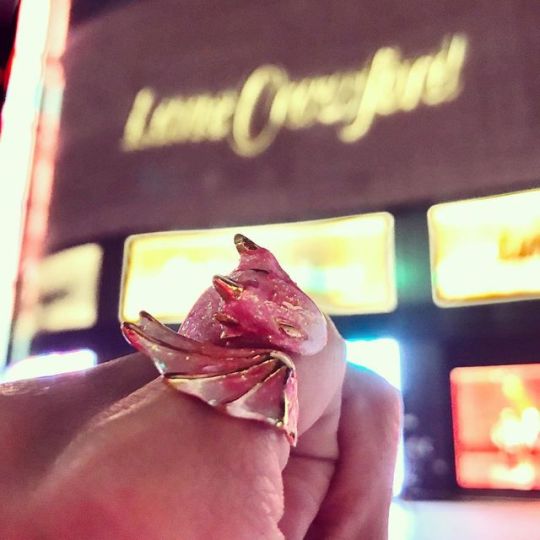
The little gold topaz dragon is sparkling through the night at Lane Crawford, Shanghai Times Square! . . . #dragonsjourney #dragonring #dragon #pinkdragonring #pinkdragon #dragonjewellery #dragonjewelry #pinkdragonjewellery #pinkdragonjewelry #dragons #adjustablering #shanghai #china #lanecrawfordshanghai #lanecrawford #lanecrawfordhk (at Lane Crawford 连卡佛 - Shanghai Times Square) https://www.instagram.com/p/BykxcqrldA9/?igshid=rcupgf4wir3g
#dragonsjourney#dragonring#dragon#pinkdragonring#pinkdragon#dragonjewellery#dragonjewelry#pinkdragonjewellery#pinkdragonjewelry#dragons#adjustablering#shanghai#china#lanecrawfordshanghai#lanecrawford#lanecrawfordhk
2 notes
·
View notes
Text
UPDATED MUSE LIST !
RIVERDALE.
veronica lodge. (camila mendes)
cheryl blossom. (madelaine petsch)
toni topaz. (vanessa morgan)
GAME OF THRONES. (season one-six)
daenerys targaryen. (emilia clarke)
robb stark. (richard madden) (canon divergent au’s available)
arya stark. (maisie williams)
THE CHRONICLES OF NARNIA.
lucy pevensie. (adelaide kane)
edmund pevensie. (sean teale)
REIGN. (season one-two)
kenna de poitiers. (caitlin stasey)
HEATHERS: THE MUSICAL.
veronica sawyer. (zendaya)
j.d. (noah centineo)
MISFITS. (season one-three)
simon bellamy. (iwan rheon)
BROOKLYN NINE-NINE.
jake peralta. (andy samberg)
rosa diaz. (stephanie beatriz)
GOSSIP GIRL.
nate archibald. (chace crawford)
chuck bass. (noah centineo)
THE VAMPIRE DIARIES/THE ORIGINALS.
kol mikaelson. (nate buzz)
bonnie bennett. (kat graham)
katherine pierce. (nina dobrev)
PERCY JACKSON AND THE OLYMPIANS/THE HEROES OF OLYMPUS.
percy jackson. (logan lerman)
annabeth chase. (lili reinhart)
DC COMICS.
bruce wayne - young. (david mazouz)
poison ivy. (kate mara)
harley quinn. (margot robbie)
THAT 70S SHOW. (season one-seven)
steven hyde. (daniel sharman)
jackie burkhart. (camila mendes)
ARCHER.
sterling archer. (henry cavill)
lana kane. (keke palmer)
TEEN WOLF.
scott mccall. (tyler posey)
allison argent. (crystal reed)
stiles stilinski. (dylan o'brien)
lydia martin. (madelaine petsch)
isaac lahey. (daniel sharman)
1 note
·
View note
Text
Crystal Valley Cemetery of Manitou Springs
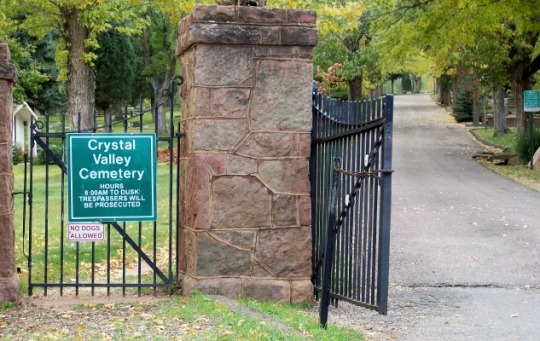
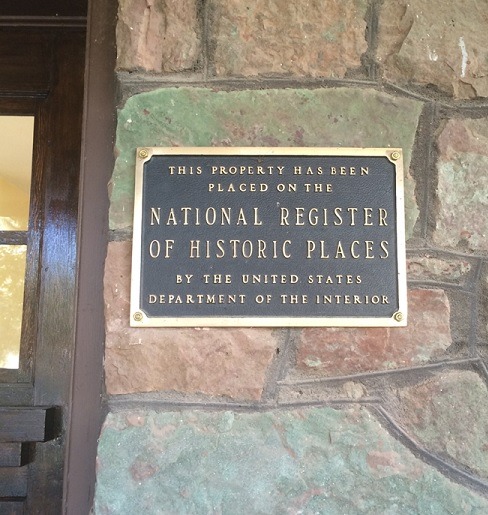
Photos courtesy of FindAGrave.com
Historical background
Crystal Valley Cemetery was incorporated as the principal cemetery in Manitou Springs, Colorado in 1890, and is historically significant as being the final resting place for many of the more prominent figures from Manitou history. Manitou Springs was founded 18 years before, so Crystal Valley isn’t actually the original site of Manitou’s pioneer cemetery. The first cemetery was located off Pawnee Avenue on Iron Mountain, on the land that Redstone Castle now sits on. RedStone Castle has it’s own haunted history, but more on that later.
Isaac Davis, a famous figure from Manitou history who turns up in my research a lot, was the original owner of the land beneath RedStone Castle, where the first cemetery was located. He had the oldest graves moved from there to the current location of Crystal Valley in the 1880s, because he wanted to develop his land. Peggie, of the Manitou Springs Historical Society, was gracious enough to take me on a walking tour of the cemetery while I was researching. With the graceful, evocative language of a local history buff who truly loves the place they live, she said of Isaac Davis: “He felt that the living would enjoy the view more than the dead.” There are a few crumbling headstones in the oldest part of Crystal Valley that mark the location of some of the displaced corpses, but the majority were reburied in unmarked graves.
In her book Haunted Manitou Springs, local author and paranormal enthusiast Stephanie Waters claims that the cemetery sits on the site of an ancient Native American burial ground and that Native American artifacts have been found on the property, including cradle boards, beads, and arrowheads. She goes on to say that the name “Crystal Valley” comes from early prospectors who called the location “Crystal City” due to its abundance of smoky quartz, purple amazonite, and yellow topaz.
Notable people interred
Since I’ve already mentioned Isaac Davis, we’ll start with him. Dr. Davis was one of the original movers and shakers in Manitou. As I mentioned earlier, Crystal Valley Cemetery wouldn’t exist without him. He was the town’s first physician, and also ran a drugstore in addition to acting as the undertaker, county coroner, town trustee, and justice of the peace. He also served as mayor for one year. Today, he is most famous for the mummification of Tom O’Neal.
Tom was a classic wild west outlaw, and died in a saloon brawl in Old Colorado City, which, for those of you that don’t know, is just up the road from Manitou. Nobody could track down his next of kin, so his body was entrusted to Dr. Davis, who used the opportunity to experiment with embalming techniques. Using potions and sun-drying, he worked on mummifying Tom’s corpse for two years. He was very successful and eventually displayed the mummy in the stone building in the original cemetery on Pawnee until the cemetery was relocated. Tom was then buried in a loose gravel grave in Crystal Valley for only a short period of time before he was stolen by grave robbers, and was last seen touring across the U.S. in a fake Native American costume as a sideshow attraction. Nobody knows where he is now.
Dr. Davis was a man of science, and was doing this as a way to further his scientific and medical knowledge. But still today, it’s really damaged his reputation, despite all the good things he contributed to Manitou in the town’s early years. People call him Dr. Frankenstein. In Stephanie Waters’ book, she says that he also had a habit of preserving dead animals, his house so full of animals preserved in jars that his wife would find them in strange places - like their kitchen cabinets.
Dr. Davis’s mother, Hannah, is also buried next to him in the cemetery, and is notable because her monument was the first erected in Crystal Valley in 1885.
Charles Adams is particularly important when discussing the history of the cemetery through the lens of researching hauntings, as his grave is the only one I found specifically mentioned in my research as being a regular site for paranormal activity. During my initial research of the cemetery, I read that his headstone is said to emanate heat at night. Wondering why, I looked into the life and death of Charles Adams.
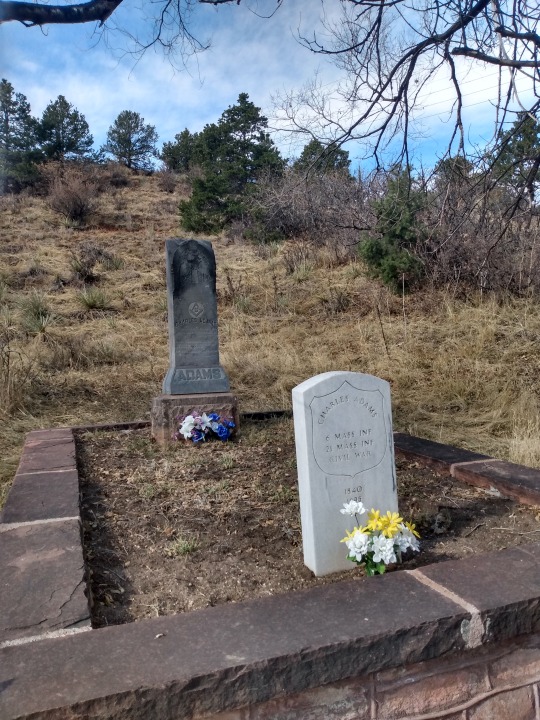
The grave of Charles Adams, taken by me in January 2020
General Charles Adams is remembered for maintaining close friendships with the local Ute Native Americans, and because of that he was able to negotiate the safe release of the kidnapped women and children following the Meeker Massacre in 1879. In 1985, he was killed in the tragic Gumry Hotel explosion in Denver. There are a few different accounts as to who was responsible for the accident, but the general consensus is that the water level of the hotel’s boiler fell below the safety valves, and the boiler overheated, causing it to explode when cold water was added. The explosion caused the walls of the hotel to blow out and the floors to collapse. 22 people were killed, including Charles Adams.

Courtesy of Newspapers.com from Newton Daily Republican

Courtesy of Denver Fire Journal & Western Fire History
No discussion of Crystal Valley Cemetery would be complete without touching on Emma Crawford. I would like to make an additional post focusing exclusively on Emma in the future, as she is perhaps the most famous figure from Manitou history, and is inexorably linked in the accounts of several separate haunted places in Manitou Springs. For now, I will include a simplified version of her story.
Emma Crawford is where Manitou gets inspiration for their famous Halloween event, the Emma Crawford Coffin Races. Emma and her family came to Manitou during the Victorian era because Emma had tuberculosis, and Colorado Springs and Manitou both were wildly popular destinations for people suffering from TB, due to the crisp, dry air, the so-called “300 days of sunshine” per year, and the famous Manitou mineral water, which people still claim to have healing powers to this day. Emma was buried at the summit of Red Mountain after dying of tuberculosis at age 28, because she had climbed the mountain on her own just a few weeks prior, and claimed to have had a spiritual experience at the top. According to Emma, she was visited by the spirit of a Native American chief, and she begged to be buried there, because she hated cemeteries and death. After a large rainfall, her casket rose to the surface and was washed down the side of Red Mountain into town - the reason we have the coffin races today. She’s now interred at Crystal Valley, although nobody knows exactly where.

Emma Crawford’s monument in Crystal Valley, taken by me in January 2020
Other notable people interred at Crystal Valley include:
Mabel Jane Willie, first female mayor of Manitou
Theresa Kenny, who built and stucco’d her own mausoleum in the ‘30s and enjoyed rocking in her rocking chair outside it prior to her death
Kelly Murphy, killed at home in Manitou in 2008 from carbon monoxide poisoning; her rental was owned by the then-current mayor of Manitou and did not have a carbon monoxide detector (though it was no the law for the house to have one at the time)
Pam Hartman and Jeanne Kerechanin, local lesbians killed in 2005 in a car accident on their way to Wisconsin for a funeral, unable to afford a flight due to being denied the bereavement price for both of them as Colorado did not recognize their union as legal
The hauntings of Crystal Valley
Paranormal activity encountered at Crystal Valley Cemetery in the past has included; heat from Charles Adam’s grave, cold spots, EVPs (electronic voice phenomenon), and photographic anomalies - which can include streaks and apparitions, but most commonly appear as orbs. Full-bodied apparitions have also been sighted, and are most commonly said to be the spirit of Tom O’Neal.
Reflective commentary
According to general consensus among paranormal researchers, spirits tend to hang around where they most suffered in life, rather than remaining with their bodies after death, making cemeteries relatively rare as haunted locations. However, it is also said that desecration of gravesites can be a common cause of paranormal activity. Because of this, I suspect that it is because so many graves were disturbed in being moved from the original cemetery on Pawnee Avenue to Crystal Valley, that paranormal encounters are said to be had in both locations.
I would also say that the conjunction between Charles Adams’s cause of death by fire and the manifestation of his haunting through the emanation of heat from his gravestone is also compelling in drawing a connection between recorded historical events and later stories of hauntings.
To me, the story of Dr. Davis and the mummy of Tom O’Neal is also exciting in approaching this historical research from the folkloric perspective. Dr. Davis was a prominent, well-respected member of his community, and it’s unfortunate that what he is remembered for today is an excitement for playing with dead things. This tells us a little bit about what locals choose to remember in the canon of their town’s history, and how this can be shaped by external forces like pop culture (”Frankenstein”).
CLICK HERE FOR FIELD NOTES AND SOURCES FOR THIS LOCATION.
0 notes
Text
The ubiquity of declarative jewelry at the Fashion Week in New York - it seems to be another result of the recession. Critics vied with each other about the death of 'It' handbags, so it took only a while for the handbags, as a must for possession of the item, to give up this function to the shoes and now - declarative jewelry. At least for New Yorkers, jewelry is a much safer investment (or, depending on the situation, buying under the influence of a rush) than design shoes that are too dependent on the state of the city pavement.
According to the nationaljewelernetwork.com portal, while showing Diane von Furstenberg at the Fashion Week in New York, watches and jewelery combined the designer's favorite theme of nomadic tribes with a sense of classic luxury.
Her proposed women's clothing from the collection of autumn 2009 - winter 2010 combined fancy hats, luxurious textiles, intricate embroidery, multilayered ligature and even pompons.
Part of the presentation was the new design clock von Furstenberg Sutra Sport, manufactured by H. Stern, along with which were shown large, catchy Sutra bracelets and "power rings".
The collection of watches Sutra, which was developed from the jewelry line, appeared in the USA, Europe and the Middle East in the autumn of 2008, and in 2009 it is planned to be released in other regions. The watches are retailed for 1,500 - 1,600 dollars and are offered in two versions: with a stainless steel case or stainless steel with a black coating.
The von Furstenburg Collection will not be the only one at the Fashion Week. Cartier plans to present its new "Trinity Line" at the 3.1 Phillip Lim show, reports the Women's Wear Daily. The collection includes the Trinity ring, originally created in 1924 and consisting of three intertwined rings of white, pink and yellow gold, embodying friendship, love and loyalty.
The portal also tells that the jewelry brand Marco Bicego has made its "face" model Bridget Hall, advertising everything from Guess Jeans and Pepsi to Valentino and Versace . And now Bridget Hall will add this jewelry design brand to its ever-growing list of well-known campaigns.
Starting with the March numbers C, Elle, Harper's Bazaar and W, the supermodel will appear in the new international printed advertising campaign of the brand 2009-2010, prepared in New York by fashion photographer Kenneth Willard.
The hall will appear in the jewelry from the collection "Jaipur", which is made of 18-carat yellow gold with colored gemstones, such as amethyst, peridot, blue topaz, pink and green tourmaline.
With the help of the creative team of Marco Bicego and her art director, Terry Pecora, Willard created an atmosphere in a minimalist taste - both urban and cosmopolitan. Advertisements convey the natural elements, which serve as a source of inspiration for all Marco Bicego projects.
Bridget Hall became famous in the 90's when she reached supermodel status, like her contemporaries Cindy Crawford and Christy Turlington.
According to Marco Bicego, a veteran of fashion shows and an experienced fashion model is the embodiment of Marco Bicego brand: feminine, refined, with dignity, full of life and aspiration.
2 notes
·
View notes
Text
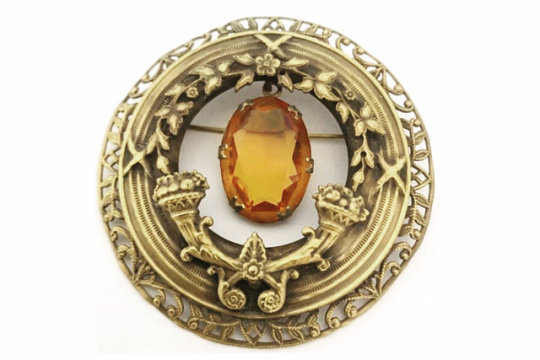
Joseff of Hollywood
A beautiful large vintage brooch by Joseff of Hollywood. This fabulous collector brooch has a large dangling multi faceted Topaz colored rhinestone center and is surrounded antique gold tone metal in a very ornate design of flowers,leaves and 2 cornucopias .Measures 2 3/4 inches and is in good vintage condition.Signed Joseff
Joseff of Hollywood was a jewelry firm, founded by Eugene Joseff. The firm was particularly noted for creating quality costume jewelry using stones from Austria & Czechoslovakia & antique gold tone metals and special finishes that worked well with the camera. They produced jewelry for many of the biggest films and movie stars of the 1930s and 1940s including Shirley Temple in The Little Princess, Vivien Leigh in Gone with the Wind, and Elizabeth Taylor in Cleopatra. Joan Crawford, Marlene Dietrich, Lucille Ball and others were known to wear and advertise Joseff of Hollywood Jewelry
1 note
·
View note
Video
My friend Steven Crow, aka Topaz Crawford, has passed. If you have any information about a GoFundMe for expenses, please respond below or message me. Thank you. #lgbtq🌈 (at Beaverton, Oregon) https://www.instagram.com/p/CBpL2Lvg1uS/?igshid=132mmekev7mgr
0 notes
Text
Chicago Blackhawks Player Birthstones [updated as of March 2017]
January (garnet)
Marian Hossa
February (amethyst)
Jordin Tootoo
Richard Panik
John Hayden
Nick Schmaltz
April (diamond)
Brent Seabrook
Jonathan Toews
May (emerald)
Brian Campbell
Artem Anisimov
Marcus Kruger
June (pearl)
Niklas Hjalmarsson
Gustav Forsling
July (ruby)
Dennis Rasmussen
Duncan Keith
Trevor van Riemsdyk
Tanner Kero
Andrew Desjardins
September (sapphire)
Michal Rozsival
Michal Kempny
Ryan Hartman
October (opal)
Artemi Panarin
November (topaz)
Patrick Kane
December (turquoise)
Scott Darling
Tomas Jurco
Corey Crawford
1 note
·
View note
Photo
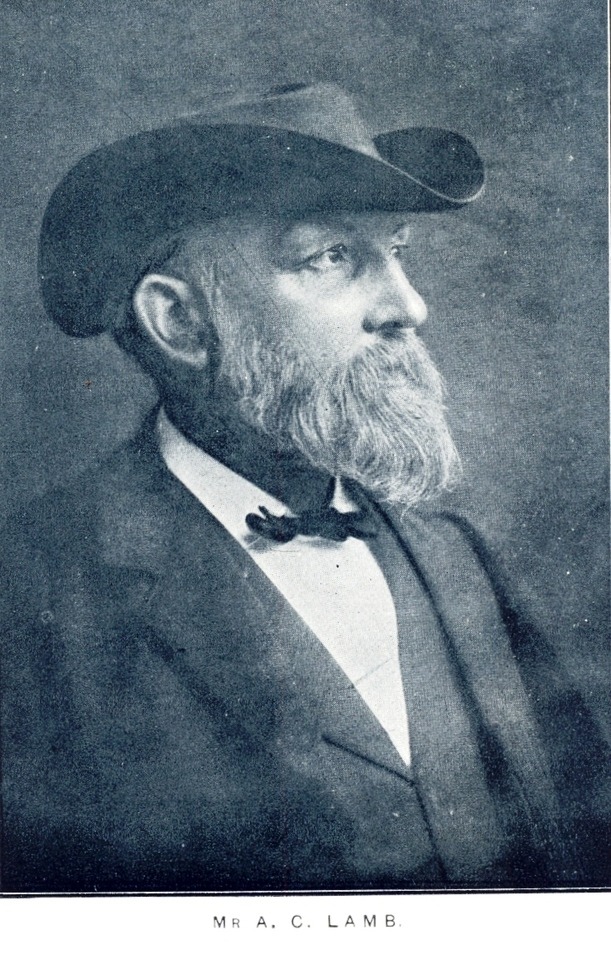
On January 21st 1843 the hotelier, art collector, antiquarian and writer Alexander Crawford (A.C) Lamb was born in Dundee.
A. C. Lamb became aware that in 1871 old buildings were disappearing due to the implementation of the Improvement Act. He therefore sought to record their existence by collecting views of anything which illustrated Dundee's trade, commerce and the activities of its citizens. Apart from being a collector of artefacts, A. C. Lamb also spent many years producing a piece of work illustrating the history of Dundee, called “Dundee: Its Quaint and Historic Buildings'”.
Lamb's hotel business was very successful and presumably provided the financial means whereby he amassed the immense Lamb Collection which "now forms one of the largest and most varied collections of local history material in Scotland".[4] On his death the collection was acquired by Edward Cox and donated to the City of Dundee. The artefacts "The Lamb Collection" are now in the City Museum.
The legacy of A,C Lamb also includes 450 boxes of ephemera, including maps, photographs, books and prints would have been lost to future generations. He was also a friend of the world famous tragedian poet William Topaz McGonagall, in his memoirs the great poet wrote about meeting Lamb before he left to spread hi genius in the U.S......".....when I called to bid him good-bye, and after we had shaken hands warmly, he asked me if any of my pretended friends had promised to take me home again from America if I failed in my enterprise. So I told him not one amongst them had promised. “Well,” says he, “write to me and I will fetch you home.”
10 notes
·
View notes